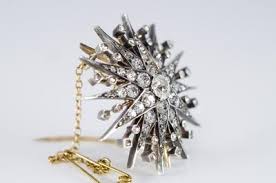Have you got any old cut diamonds languishing in the back of your jewellery box? At Pruden and Smith we specialise in redesigning them for you. We love the results we’re getting using the diverse shapes of these lovely old gems such as this old cut diamond ring. These antique diamonds are rare and unique, created by hand. The level of craftsmanship and skill required to create a beautiful diamond using only the most basic bruting techniques is astonishing. The connection that the diamond cutters had with their creations was much more labour intensive and personal than with modern laser cutting and each stone has it’s own character. Much more emphasis was put on the natural beauty of the diamond. Most of these older stones would come from the mines of Brazil and Venezuela.




An old cut diamond comes in many forms. The most commonly found old cut that we see mounted in items like this ring or brooch are the Old European Cut. These are are the earlier version of the modern round cuts that we know today. They are as close to a round shape as the diamond cutters were able to create when cutting by hand. Though not technically as perfect as the modern brilliant round cut diamonds, these diamonds are also often taller than modern cuts. Contemporary cutting techniques on the other hand, tend to focus on keeping the bulk of the carat weight- and therefore the value – in the face of the diamond. This cut often features a large, flat culet which is clearly visible through the face of the diamond. The old European cut dates back to the 1800s, and was most prominent during the Victorian, Edwardian and Art Nouveau eras.

The rarest style is incredibly ancient and rare, originating from 1300. This was the first known diamond cut because it was the closest shape to the natural octahedral form which the diamond would’ve been discovered in. Most antique Table cuts are so precious that they are housed in museums or private collections, rather than being available to the public. Rose Cuts or Dutch Cut are the only diamond cut in which there is not one primary flat face facet. Instead there are multiple cuts, all of which form a dome shape above the jewellery setting, rather than having a flat peak. This cut is known as both a rose cut and a Dutch cut. Its ‘rose’ comparison arose due to the fact that the diamond cut resembles the shape of a rose bud. This unique cut dates back to the 1500s and was common during the Victorian, Edwardian and Georgian eras. Old Mine Cut Diamonds are distinctive as they have a more square shape than the Old European Cut. It is a more basic, simplistic, and less delicate style than the Old European Cut. The most distinct feature of the old mine cut diamond is the fact that they were handcrafted, meaning that the facets, sides and rounded corners are not uniform. This is unique amongst diamond cuts, as now the value of diamonds is rooted in their uniformity within their specific cut.
Why Choose Old Cut Diamonds?
Previously, these stones would’ve been purchased as rough material to be re-cut into a more fashionable shape. Now however, because they are rarer, people are appreciating the stones for the historical significance that they hold.




Some old cut diamonds re-purposed at the end of 2017. we love the way the uneven shapes give an organic and rocky feel to these pieces.













